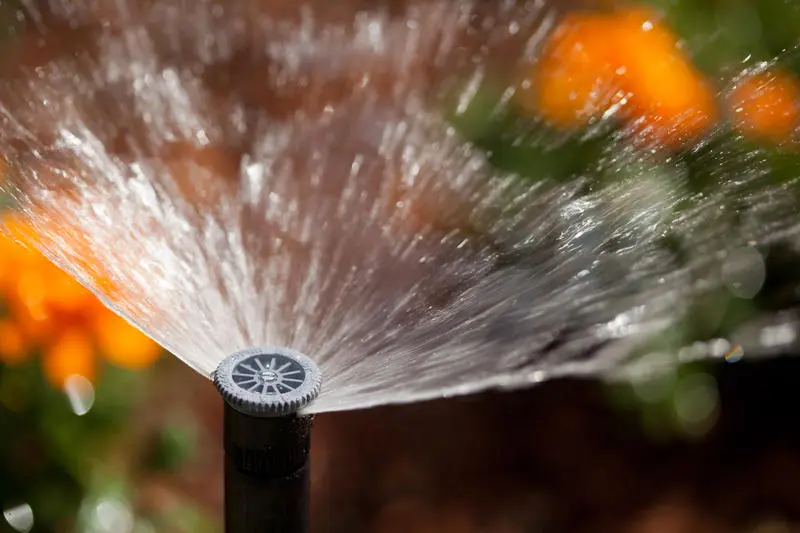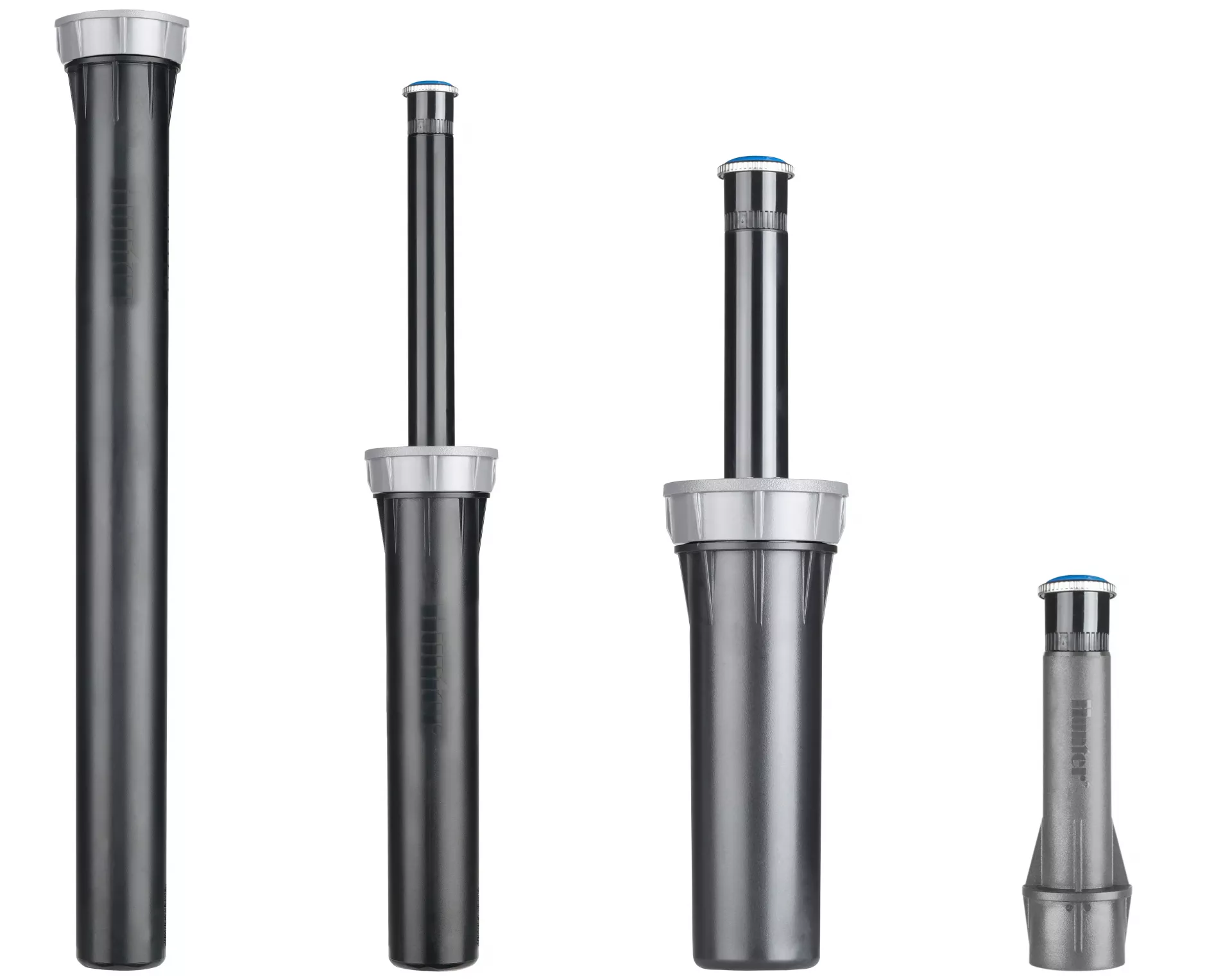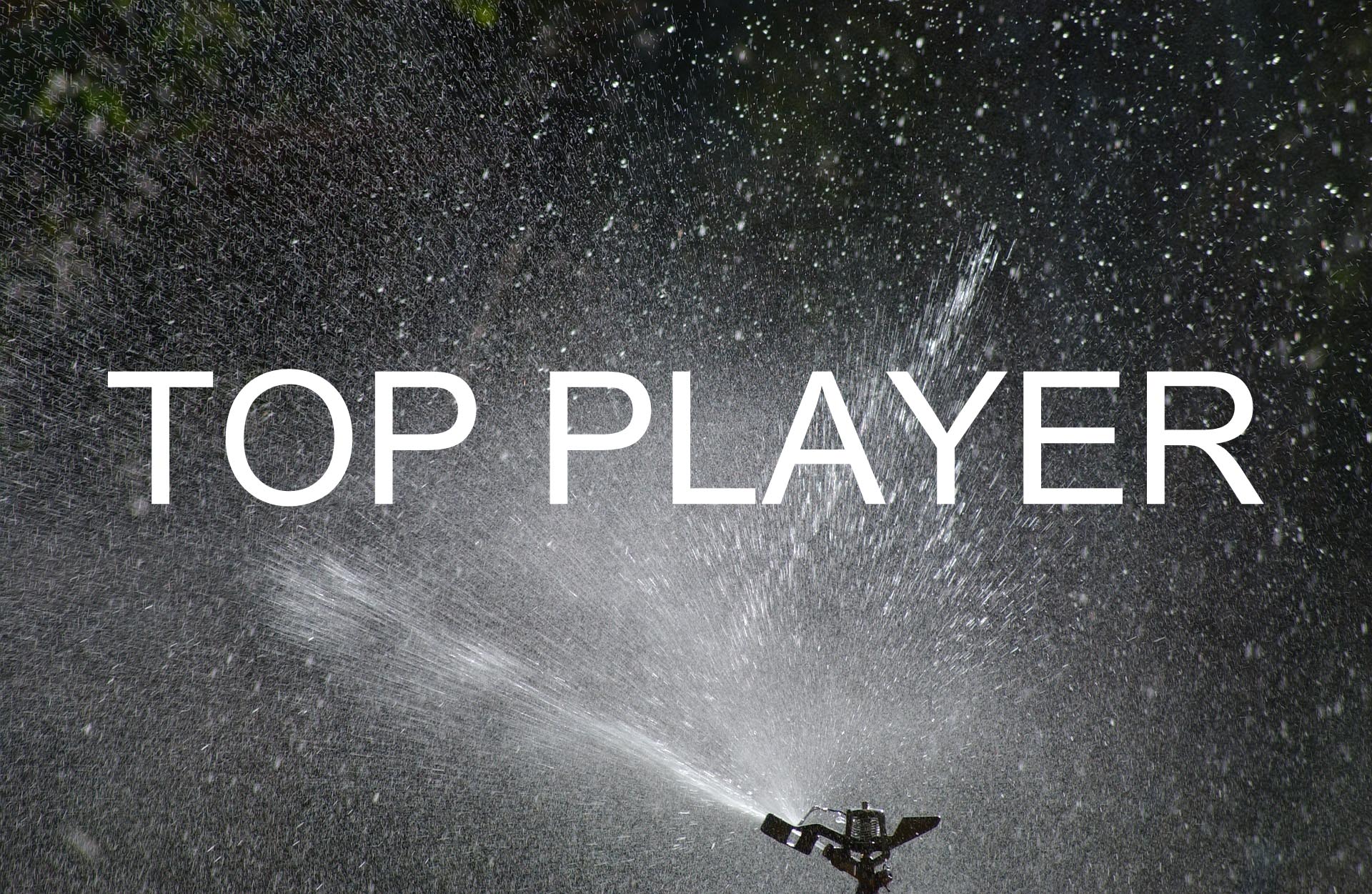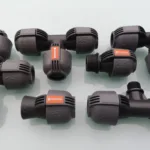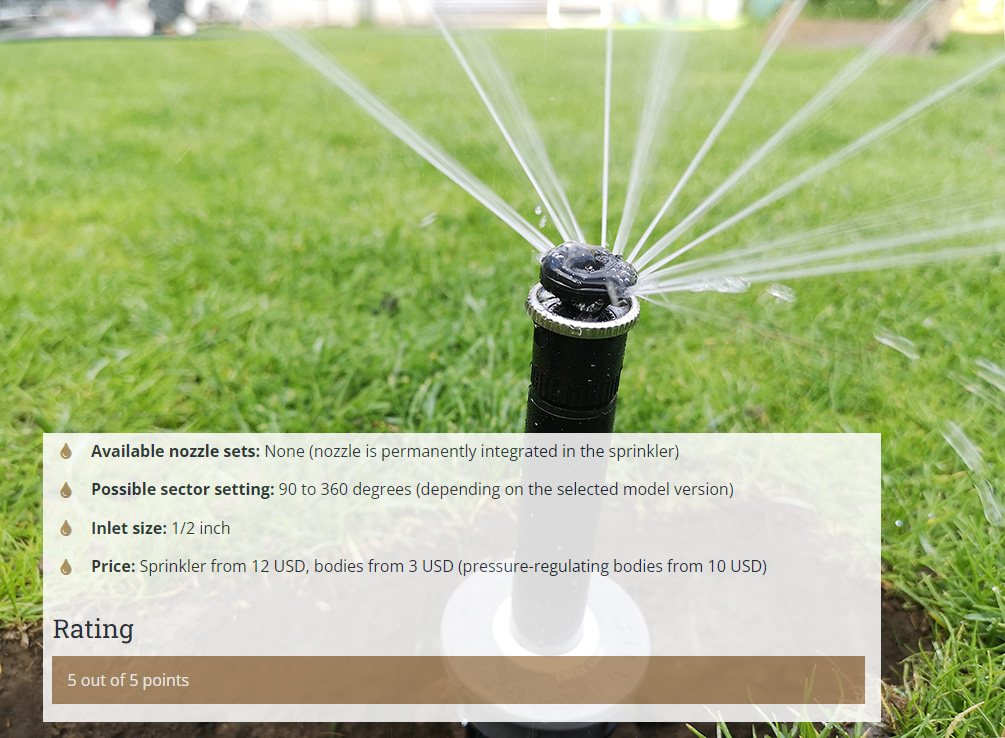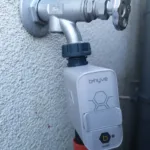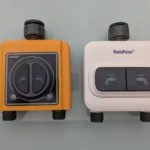This blog post gives an overview of the sprinkler nozzels available on the market, also known as spray nozzles or sprayers. Sprayers release the water like a shower head in a torrent in all directions to be sprinkled. Unlike the geared sprinklers, which rotate and only eject the water in a specific direction in a concentrated jet. These are covered in a separate blog post on rotating sprinkler performance data.
Spray nozzles are used for irrigating rather small areas and release a relatively large amount of water to the irrigated area in a short time, so they have a high precipitation rate. Accordingly, they must not be mixed in a sector with geared sprinklers, which have a significantly lower precipitation rate, and they can only irrigate a smaller area in a sector than would be the case with geared sprinklers. An exception here are the rotating nozzle sprinklers, which are a cross between spray sprinklers and rotating sprinklers. These do not emit the water in torrents, but rather in fine jets due to their rotating nozzle and therefore also have a significantly lower precipitation rate than standard sprayers.
Spray sprinklers use less water pressure than geared sprinklers. They are best used for irrigating small areas up to a maximum length of 13 to 16 feet with a floor plan with many curves or corners. The targeted sprinkling of individual trees or bushes that have a very high water requirement is also a possible using scenario.
Separation of nozzle and body
Unlike geared sprinklers, spray sprinklers have a separate nozzle and body. So you don’t buy the complete spray sprinkler, but a spray nozzle and a body and then combine these two to form the sprinkler. This has the advantage that, depending on the application scenario, you can combine a specific nozzle with a specific body that is best suited for the scenario. It is also practical to use, since if a nozzle is defective or if you are experimenting with different nozzle types or sizes, you only have to unscrew the nozzle from the body and screw in a new one instead of digging out the entire sprinkler and installing the new one.
The nozzle of the spray sprinkler differs significantly from the nozzle on the geared sprinkler: With geared sprinklers, most sprinklers come with entire nozzle sets, sometimes with up to 8 or more different nozzles. These are small nozzles measuring maybe 0.5 x 0.5 inches, of which you insert the desired one into the sprinkler riser. The nozzles of the nozzle sprinkler, on the other hand, are much larger and combined with a filter. You screw it on top of the riser of the body. You don’t buy a set of nozzles here either, but rather the exact nozzle you want, i.e. the type of nozzle you want with the desired throw range. The nozzle also makes up a larger part of the total sprinkler price for spray sprinklers compared to geared sprinklers. This is especially true for rotating nozzle sprinklers, where the nozzle, filter and rotating mechanism make up the actual sprinkler and the body accounts for the smaller part of the cost.
In the following, I will present the nozzles available on the market across all brands, together with their specific performance data. The matching bodies can be found in a separate blog post.
Overview of the nozzles available on the market
As a beginner, you can easily be overwhelmed when it comes to the nozzles, as there are a large number of different nozzles on offer, the difference between which is not immediately apparent at first glance and which also have different designations depending on the manufacturer.
Fixed arc nozzles
These nozzles spray a fixed part of a circle, 90 degrees, 180 degrees or 360 degrees, depending on the nozzle selected. A sector deviating from this cannot be irrigated. The advantage is that they reliably irrigate the predefined sector, you don’t have to set it up and it can’t be adjusted. In addition, the precipitation rates of the different sector sizes are coordinated within the same nozzle size, so that a uniform precipitation rate (MPR) can be achieved if only one nozzle size is used within an irrigation sector.
| Hunter Pro with fixed arc | Rain Bird U | |
|---|---|---|
Auto Amazon Links: No products found. |
Rainbird Plastic U...$5.99 |
|
| Nozzle type | Fixed arc | Fixed arc |
| Sector setting | Fix, different nozzles for 90, 120, 180, 240, 270 and 360 degrees | Fix, different nozzles for 90 and 360 degrees |
| Radius | 5 to 17 feet (6 different nozzle models) | 5 to 15 feet (4 different nozzle models) |
| Water flow per hour | 5 to 160 gallons | 8 to 220 gallons |
| Precipitation rate per hour | From 1.53 to 2.08 inches (square) or 1.63 to 2.08 inches (triangle) | From 1.58 to 2.14 inches (square) or 1.83 to 2.47 inches (triangle) |
| Pressure range | 15 to 40 psi | 15 to 30 psi |
| MPR | No/Yes (when using the same nozzle size consistently) | No/Yes (when using the same nozzle size consistently) |
| Special feature | Second orifice for close-in watering |
Variable arc nozzles
With these nozzles, the sector to be irrigated can be variably adjusted. You don’t need a nozzle that is tailored to the section of a circle, but you can flexibly define the section to be sprinkled on the nozzle, which gives you greater flexibility.
| Rain Bird VAN | Rain Bird HE-VAN | Hunter Pro with variable arc | |
|---|---|---|---|
Rain Bird 10-Van V... |
HE-VAN-10 Rainbird...$28.75 ($28.75 / Count) |
Hunter 12A Adjusta... |
|
| Nozzle type | Variable arc | Variable arc | Variable arc |
| Sector setting | 0 to 360 degrees or 0 to 330 degrees (depending on the model) | 0 to 360 degrees | 0 to 360 degrees |
| Radius | 3 to 18 feet (7 different nozzle models) | 6 to 15 feet (4 different nozzle models) | 4 to 17 feet (7 different nozzle models) |
| Water flow per hour | 13 to 320 gallons | 13 to 220 gallons | 5 to 340 gallons |
| Precipitation rate per hour | From 1.58 to 10.27 inches (square) or 1.82 to 11.86 inches (triangle) | From 1.58 to 3.19 inches (square) or 1.83 to 3.68 inches (triangle) | From 1.46 to 7.93 inches (square) or 1.68 to 9.15 inches (triangle) |
| Pressure range | 15 to 30 psi | 15 to 30 psi | 20 to 40 psi |
| MPR | No/Yes (when using the same nozzle size consistently) | No/Yes (when using the same nozzle size consistently) | No/Yes (when using the same nozzle size consistently) |
| Special feature | Further development of the VAN nozzles with more even sprinkling and improved close-range irrigation | Variable arc nozzle models are denoted with “A” after them: 4A, 6A, 8A, … |
| Toro T-VAN | |
|---|---|
Toro 53734 Adjusta... |
|
| Nozzle type | Variable arc |
| Sector setting | 0 to 360 degrees |
| Radius | 8 to 17 feet (5 different nozzle models) |
| Water flow per hour | 42 to 336 gallons |
| Precipitation rate per hour | From 1.02 to 4.56 inches (square) or 1.17 to 5.26 inches (triangle) |
| Pressure range | 20 to 50 psi |
| MPR | No |
| Special feature |
MPR nozzles
The precipitation rates of these nozzles are matched to one another, so that you always have the same precipitation rate (MPR) even when using different nozzle sizes. The Rain Bird and Toro nozzles work like the typical spray nozzles, so they have a comparatively high precipitation rate. The MPR nozzles are fixed sector nozzles. Depending on the sector size to be irrigated, you have to use the desired sector model, e.g. full circle, semicircle or quadrant. At Rain Bird, the MPR nozzles also have the same precipitation rate across sectors. At Toro, the same precipitation rate only applies to the different nozzle sizes with the same radius – and again only approximately.
| Rain Bird MPR | Toro MPR Plus | |
|---|---|---|
Rainbird 5Q 5' Rad...$3.67 |
Toro 5 Pack, 570 M... |
|
| Nozzle type | MPR, fixed arc | MPR, fixed arc |
| Sector setting | Fix, different nozzles for 90, 120, 180, 240, 270 and 360 degrees | Fix, different nozzles for 90, 120, 180, 240, 270 and 360 degrees |
| Radius | 3 to 15 feet (5 different nozzle models) | 5 to 15 feet (5 different nozzle models) |
| Water flow per hour | 3 to 220 gallons | 3 to 275 gallons |
| Precipitation rate per hour | From 1.52 to 3.10 inches (square) or 1.75 to 3.58 inches (triangle) | From 1.21 to 1.86 inches (square) or 1.40 to 2.15 inches (triangle) |
| Pressure range | 15 to 30 psi | 20 to 75 psi |
| MPR | Yes | No/Yes (when using the same nozzle size consistently) |
| Special feature | YES (limited, only across nozzle sizes) |
Rotating nozzles (rotating nozzle sprinklers)
This is actually a separate sprinkler category that no longer has much in common with the original nozzler sprinkler (sprayer), but is more of a cross between a sprayer and a geared sprinkler. The nozzle head includes a rotation mechanism that ensures that the water is not released in a gush, but divided into jets and that the jets are released at different points parallel to the rotation of the nozzle head. As a result, the precipitation rate is significantly lower than with a conventional sprayer. With the amount of water available, you can irrigate a much larger area at the same time. In return, however, it has to be watered longer than with conventional nozzles.
The radius of the rotating nozzle sprinklers is also greater than that of conventional nozzle sprinklers and reaches up to 35 feet. All three rotating nozzle sprinklers presented automatically also provide MPR, i.e. they are also MPR nozzles at the same time. The nozzles are a cross between nozzles with a fixed arc and nozzles with a variable arc: Different nozzles are required to cover all sector sizes, these can be adjusted within a specified range, e.g. 90 to 210 degrees or 210 to 270 degrees. Only the nozzle to cover a full circle (360 degrees) is not adjustable. The Hunter MP Rotator is my top pick for a sprinkler.
| Hunter MP-Rotator | Rain Bird R-VAN | Toro Precision | |
|---|---|---|---|
Hunter MP1000-90 A... |
Rain Bird R-VAN172...$8.99 |
Toro 53927 Precisi...$4.19 |
|
| Nozzle type | Rotating nozzle, fixed sector (adjustable within certain limits) | Rotating nozzle, fixed sector (adjustable within certain limits) | Rotating nozzle, fixed sector (adjustable within certain limits) |
| Sector setting | Depending on the model (3 different sector models) | Depending on the model (2 different sector models) | Depending on the model (9 different sector models) |
| Radius | 8 to 35 feet (4 different nozzle models: MP1000, MP2000, MP3000, MP3500) | 13 to 24 feet (3 different nozzle models: R-VAN14, R-VAN18, R-VAN24) | 5 to 15 feet (5 different nozzle models) |
| Water flow per hour | 11 to 218 gallons | 16 to 224 gallons | 3.6 to 144 gallons |
| Precipitation rate per hour | Approx. 0.40 inches (square) or 0.46 inches (triangle) | Approx. 0.63 inches (square) or 0.73 inches (triangle) | Approx. 1.0 inches (square) or 1.2 inches (triangle) |
| Pressure range | 25 to 55 psi | 30 to 55 psi | 20 to 70 psi |
| MPR | Yes | Yes | Yes |
| Special feature |
Bubblers
Deliver water directly to the root area of the plant. This comes out with minimal pressure and hardly any throw distance directly at the nozzle or in the immediate vicinity of the nozzle and is released at close range to the ground surface. Depending on the model, this can be done either in surges in the form of an umbrella or divided into jets. Bubbler nozzles are used for watering individual trees or shrubs that require more water than the surrounding vegetation, or for watering very small areas.
| Rain Bird Bubbler 1400 | Toro pressure compensating Bubbler | Hunter PCN Bubbler | |
|---|---|---|---|
Rain Bird 1400 Ser...$9.95 |
Auto Amazon Links: No products found. |
Hunter PCN-10 PCN-...$5.49 |
|
| Nozzle type | Bubbler | Bubbler | Bubbler |
| Sector setting | Full circle (360 degrees) | Depending on the model 90, 180 or 360 degrees | Full circle (360 degrees) |
| Radius | 1 to 3 feet | No information | 1 to 3 feet |
| Water flow per hour | 15 to 120 gallons (4 models 1401, 1402, 1404 and 1408 with different flow rates) | 15 to 120 gallons (3 models FB-25-PC, FB-50-PC and FB-100-PC with different flow rates and 1 model FB-200-ADJ with adjustable flow) | 15 to 120 gallons (4 models PCN-25, PCN-50, PCN-10 and PCN-20 with different flow rates) |
| Pressure range | 20 to 90 psi | 20 to 75 psi | 15 to 70 psi |
| Special feature | With the FB-200-ADJ model, the flow can be adjusted manually |
In addition to the above, there are the following types of nozzles for special tasks:
Strip nozzles
Used for watering narrow, rectangular areas (lawn strips). Three different nozzles are always required to water a rectangle (nozzle in the left corner, nozzle in the right corner, nozzle in the middle).
| Hunter Strip Pattern Nozzle | Hunter MP-Strips | Rain Bird 15 MPR Strip Series Nozzle | |
|---|---|---|---|
Hunter Sprinkler S... |
Hunter Sprinkler M...$10.06 |
Rainbird 15CST 15'... |
|
| Nozzle type | Strip pattern | Strip pattern | Strip pattern |
| Sector setting | Rectangle (3 nozzles required: LCS-515, RCS-515, SS-530) | Rectangle (3 nozzles required: MPLCS-515, MPRCS-515, MPSS-530) | Rectangle (3 nozzles required: 15RCS, 15LCS, 15SST) |
| Radius | From 5 x 15 feet to 5 x 30 feet | From 5 x 15 feet to 5 x 30 feet | From 3 x 11 feet to 4 x 30 feet |
| Water flow per hour | 26 to 87 gallons | 10 to 32 gallons | 21 to 71 gallons |
| Pressure range | 20 to 40 psi | 30 to 55 psi | 15 to 30 psi |
| Special feature | Rotating nozzle |
Short radius and stream spray nozzles
Short-radius nozzles are nozzles with a short throw distance that is always the same, regardless of the water pressure, for watering in very small spaces. Stream spray nozzles divide the water jet into individual jets and have a lower precipitation rate compared to conventional spray nozzles.
You can find the right bodies to turn the nozzle into a nozzle sprinkler in a separate blog post.

